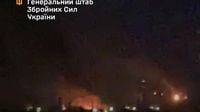In a dramatic escalation of the ongoing conflict, Ukraine’s military has launched a series of high-precision drone strikes against key Russian infrastructure and military targets, with the Ryazan oil refinery—located about 200 kilometers southeast of Moscow—emerging as the most significant casualty. The attacks, which unfolded late on November 15 and into the early hours of November 16, 2025, mark a new phase in Ukraine’s strategy to undermine Russia’s military and economic capabilities, according to statements from the General Staff of the Armed Forces of Ukraine and corroborated by multiple international news organizations.
The Ryazan refinery, Russia’s fourth largest and a critical node in the nation’s energy network, processes approximately 262,000 barrels of oil per day. It produces a variety of fuels, including A-92/95/98/100 gasoline, diesel, liquefied gases, and most notably, around 840,000 tonnes annually of TS-1 aviation kerosene—a crucial fuel for the Russian Aerospace Forces. According to the Ukrainian military, this facility was deliberately targeted to reduce Russia’s ability to launch missile and bomb attacks against Ukrainian territory. "As part of reducing the enemy’s capabilities to carry out missile and bomb strikes, units of the Defense Forces of Ukraine hit Ryazan oil refinery in Russia’s Ryazan region," the General Staff announced on its official Telegram channel.
Eyewitness accounts and local reports described the aftermath as chaotic, with numerous explosions and a significant fire engulfing the refinery. The incident was further confirmed by Ryazan Governor Pavel Malkov, who stated via Telegram that Russian air defenses had shot down 25 Ukrainian drones overnight, but debris from the downed drones caused a fire inside the industrial facility. The strike resulted in partial production halts at the refinery, a blow to Russia’s domestic fuel supply and its military logistics chain.
The Ryazan attack was not an isolated event. On the same night, Ukraine’s Defense Forces also struck a Nebo-U radar station in the temporarily occupied territory of Crimea. This radar system is considered a key component of Russia’s air surveillance apparatus, and its destruction could significantly impair Russian early warning and air defense capabilities in the region. The Ukrainian military further reported successful hits on a military convoy near Tokmak in the Zaporizhzhia region and on concentrations of Russian personnel near Vovchansk in the Kharkiv region—both areas currently under Russian occupation. The full results of these strikes are still being assessed, with Ukrainian officials stating, "The results of the hits are being clarified."
The ripple effects of these attacks extended beyond Ryazan. In Volgograd, another Russian city, local sources reported drone strikes on the Lukoil oil refinery, with preliminary information suggesting several hits. Russian air defense efforts, while attempting to repel the drone onslaught, inadvertently caused damage to an apartment building, highlighting the risks of urban warfare and the unpredictable nature of drone technology in modern conflict.
These Ukrainian strikes come on the heels of a deadly Russian attack on Kyiv on November 14, which killed seven civilians, including a couple in their seventies and a 62-year-old man. An elderly woman injured in the shelling died the following morning, as reported by Kyiv city administration chief Taimur Takachenko. The cycle of attack and retaliation underscores the intensifying tit-for-tat dynamic that has characterized the war since Russia’s full-scale invasion in February 2022.
The broader strategic context of Ukraine’s campaign is clear: by targeting Russian oil infrastructure and military assets deep inside Russian territory and in occupied regions, Kyiv aims to cripple Moscow’s ability to finance and sustain its military operations. As reported by Devdiscourse, Ukraine’s military openly acknowledged that these strikes are part of a deliberate effort to hamper Russia’s invasion financing capabilities. The General Staff echoed this sentiment, stating, "The Defense Forces continue taking all necessary measures to undermine the military-economic and offensive potential of the Russian occupiers and to force the Russian Federation to stop its armed aggression against Ukraine."
Meanwhile, Russia has mounted its own offensives. The Russian Defense Ministry announced on November 16 that its forces had gained control over a settlement in Zaporizhzhia and had struck energy facilities, military airports, and communication centers supporting Ukraine’s defense industry. In the Zaporizhzhia region, Yevgeny Balitsky, a Moscow-appointed governor, reported that Ukrainian attacks on key infrastructure led to temporary power outages affecting about 44,000 people. Repair teams have since begun restoring electricity, but the disruption highlights the vulnerability of civilian infrastructure amid the ongoing hostilities.
Amidst the military escalation, diplomatic developments have also emerged. Rustem Umerov, secretary of Ukraine’s National Security and Defense Council, announced that following negotiations between Ukraine and Russia, both sides had agreed to uphold a prisoner swap deal previously reached in Istanbul, with 1,200 Ukrainian detainees expected to be freed. While Russia has not officially commented on the matter, the agreement, if implemented, could offer a rare glimmer of hope for families on both sides of the conflict.
The strikes on the Ryazan refinery and other targets are only the latest in a pattern of Ukrainian drone and missile attacks inside Russian territory, a tactic that Kyiv has employed regularly since 2022. The previous day, drones attacked the oil terminal in Novorossiysk, temporarily halting 2% of global oil shipments, according to Reuters. These operations not only disrupt Russia’s war machine but also send a clear message to Moscow that Ukraine retains the capability to strike far beyond the front lines.
For ordinary Russians, the attacks have brought the realities of war closer to home. The fires and explosions in Ryazan and Volgograd, coupled with widespread power outages in Zaporizhzhia, have underscored the vulnerability of even well-defended regions. For Ukrainians, especially those in cities like Kyiv and Nikopol who continue to endure Russian missile and drone strikes, the recent counterattacks may offer a sense of agency but also raise fears of further escalation and retaliation.
As both sides trade blows—militarily and diplomatically—the conflict shows no signs of abating. With each new strike, the stakes grow higher, and the line between military and civilian targets becomes ever more blurred. The world watches anxiously, wondering what the next move in this high-stakes confrontation will be.






